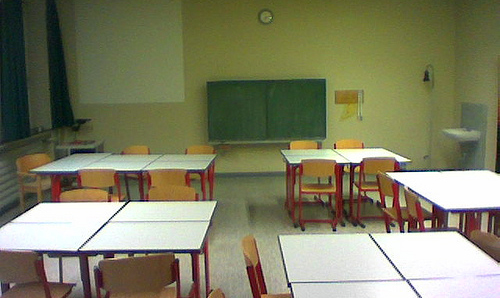School suspensions go beyond just quick-fix discipline to get an unruly student out of the way. A single suspension triples the chance of a kid getting in trouble with the law that year, remarked California Supreme Court Justice Hon. Tani G. Cantil-Sakauye. And like a lot of juvenile justice statistics, the numbers show that suspensions disproportionately affect black and Latino students, most of them boys.
This means suspensions could be classified as a civil rights issue.
The Santa Clara County Board of Education will hear a report about local suspension numbers when it meets Wednesday night. The figures show that most of the county’s public school suspensions were discretionary.
In California, 400,000 students were suspended a total of 750,000 times, according to a University of California, Los Angeles study. More than 40 percent statewide were for “willful defiance,” a subjective rationale.
In Santa Clara County, which counted an enrollment last school year of 265,618 pupils, 52 percent of the 19,770 suspensions last year were “discretionary,” ordered for things like “willful defiance,” cutting class and smoking on campus, according top a 2012 report from child advocacy group Kids in Common.
Dana Burnett, director of Kids in Common, and Mariel Caballero, of the Santa Clara County Public Defender’s Office, will deliver a report titled “Zero Suspension Policy,” which outlines not only recent stats but also suspension alternatives.
Suspension numbers have actually dropped from a few years ago, although the numbers remain high. In the 2009-10 school year, when the county enrolled 263,984 students, 547 were expelled—mostly for violence- and drug-related offenses—and 21,417 were suspended for, many for similar reasons. In the 2010-11 academic calendar, 508 of the 265,618 students enrolled got expelled and 19,770 were suspended.
Suspended students were more likely to repeat a grade, get caught up in a crime of some type or drop out of school, the report says. Kids who got caught up in the juvenile justice system were four times as likely to drop out.
For the past two years, the county has studied alternatives to suspension, like in-school detention, accountability tracking, drug and alcohol prevention and community service. Four campuses in the East Side Union high School District rolled out pilot programs with the National Center for School Engagement to test suspension alternatives.
This school year alone, the pilot schools reported up to a 40 percent drop in the number of students suspended for a collective 578 fewer suspension days. East Side as a whole saw a 30-percent drop in the number of suspended students and 1,181 fewer suspension days. Since schools receive per-pupil funding based on daily attendance, keeping kids on campus saved the district $90,000 this year.
Other items from the Santa Clara County Board of Education agenda for April 17, 2013:
• Since Bullis Charter School opened more than a decade ago, it’s been plagued by legal bickering between the itself, the Los Altos School District and the county Office of Education.
Earlier this month it was Bullis’ turn to deliver an annual progress report to county education officials, as all charter schools in the region do. A former Bullis parent shot back a critique of the presentation, noting that the presenter miscalculated the number of special needs students in the charter school and the larger Los Altos district. That’s significant—says wealthy tech exec Mike Uhler, whose kids used to attend Bullis—because it misrepresents how much money in services the school and the district provide to students enrolled in special education courses.
County trustee Julia Hover-Smoot added her own letter to the public record, which raised questions over whether the Bullis conversation at the April 3 board meeting violated the Brown Act. Board President Grace Mah respectfully disagrees that it did.
Charter schools constantly receive flak for challenging conventional public school education models—just look at the debate over the Rocketship Tamien site—but none more so in this region than Bullis. That’s because the public charter lies in one of the wealthiest zip codes in the nation, where the median home price sits at around $1 million and the average family household income comes close to $220,000. The Los Altos hills are populated by some of the richest folks in Silicon Valley. Mah, who originally voted for the charter, changed her mind in recent years when she questioned whether the campus granted equal access to poor families.
Bloomberg News bluntly described the Bullis problem in a headline a couple years ago, “Taxpayers Get Billed for Kids of Millionaires at Charter School,” because of the legal fees required to cover the lawsuit against the school district.
WHAT: Santa Clara County Board of Education meets
WHEN: 5pm Wednesday
WHERE: County Education Offices, 1290 Ridder Park Drive, San Jose
INFO: 408.453.6500


Of course school suspensions are a civil rights issue… as is every other issue in which the chronic failure or dysfunction of a sociologically-anointed class has proven itself to be endemic.
I predict a decrease in suspensions will be accompanied by an increase in enrollments in private schools. Students beyond the control of teachers create hell for their fellow students.
This suspensions issue has gotten so bent out of proportion that rational persons are now supposed to believe that suspensions are indiscriminately issued to male, minority students and that is causing them to drop out of school and be a drain on society.
Talk about collecting a lot of data, and then either misinterpreting it, or twisting it to create a cause that will require more tax dollars to be spent fixing the wrong problem.
The most ridiculous statement, and least compelling argument was, “Kids who got caught up in the juvenile justice system were four times as likely to drop out.” Well, yeah! They seemed to have put themselves on that trajectory, and without parental intervention. The key to fixing this problem starts with those parents providing more and better parenting. Suspensions are the unfortunate by-product of the lack of parenting.